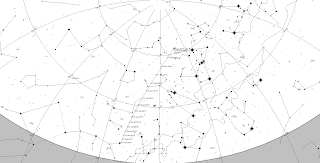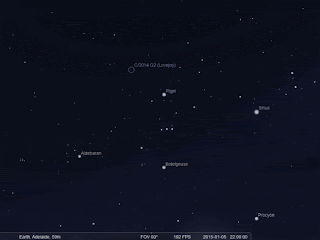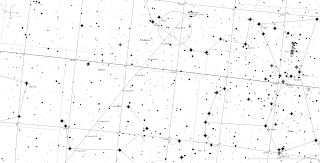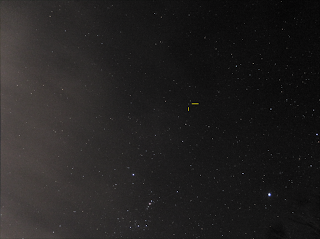Comet C/2014 Q2 Lovejoy, the Christmas Comet, is brightest this Sunday, January 11. Not that it will be obvious, at a predicted magnitude 4.5 it will be quite dim and be only marginally brighter than the days before or after. However, it is bright enough to be seen with the unaided eye in dark sky locations during the next two weeks, and people with good eyesight may glimpse it with the unaided eye from relatively unpolluted suburban locations.
What follows is a simple guide to finding the comet, with printable star charts. The comet is very easy to see in binoculars or a small telescope, so if you have them, this guide will help you too.
Over the next few days the Moon leaves the evening sky, and once again comet C/2014 Q2 Lovejoy has a chance to shine again. Even with full Moon, comet Lovejoy has been easy to see in binoculars. Sketch of comet Lovejoy near the globular cluster M79 on 29 December made using 10x50 binocularsIan Musgrave
With the Moon waning and rising later the comet, which is brightening as it heads towards maximum brightness on January 11, should now be easily seen as a dimmish fuzzy star with the unaided eye. In binoculars it looks like a large ball of cotton wool and in even small telescopes a thin faint tail can be seen. For the next 7-8 days the obvious constellations of Orion and Taurus are your guide to finding the comet. The comet is currently around magnitude 4.8, and may get as bright as 4.5 or hopefully even brighter.
If you go out when the sky is dark (a little after 10:20 pm daylight saving
time in most of Australia), and look north-east you will see the distinctive shape of the “saucepan” almost dead ahead of you.
Just above this is a bright-blue white star, Rigel.
For the next few days if you sweep your eyes (or binoculars) north you will follow a trail of brightish stars, these form the celestial river Eridanus. After you have passed the fifth star and before the sixth is the space where the comet will pass. There are no bright globular clusters in this area so the comet is distinctive as a fuzzy star to the unaided eye, and a large fuzzy ball in binoculars or telescopes. You may need to locate it in binoculars before you are confident of a visual sighting. If you watch on consecutive days you can see the comet move.
From around the 8th start your sweep at the saucepan it self, then from the 10th the comet is nestled between the legs of Taurus the Bull. Start your sweep at blue-white Bellatrix, the bright star below and to the north of the saucepan (not the bright red Betelgeuse below and to the south), towards the like of stars that marks Orion’s shield and then on further to a U shaped group of faintish stars, just above the obvious inverted “V” that is the head of Taurus. The “U” shape is where the comet will be at its brightest.
Once again, the printable charts above can help you with your quest. For telescope
users, the image will be upside down compared to the charts. Remember,
when looking for the comet allow at least 5
minutes for your eyes to adjust and become dark adapted. Here’s some hints on dark adaption
of your eyes. If using the charts above, cover your torch with red cellophane so as to not destroy your night vision.
Good comet hunting!
 Comet Lovejoy imaged with a remote telescope at Siding Springs Observatory on January 3, 2015Ian Musgrave
Comet Lovejoy imaged with a remote telescope at Siding Springs Observatory on January 3, 2015Ian Musgrave
Ian Musgrave does not work for, consult to, own shares in or receive funding from any company or organisation that would benefit from this article, and has no relevant affiliations.
| < Prev | Next > |
|---|








-1.png)



